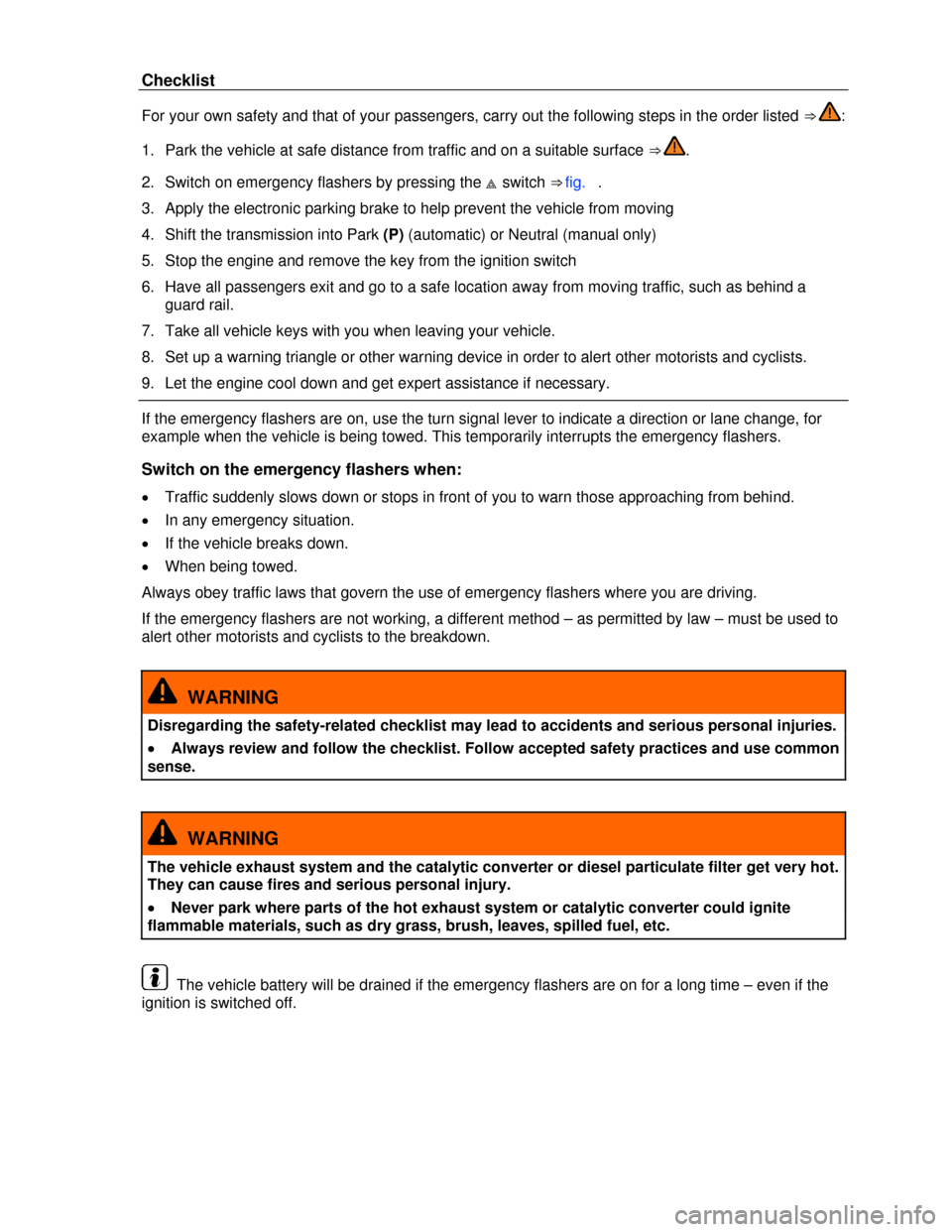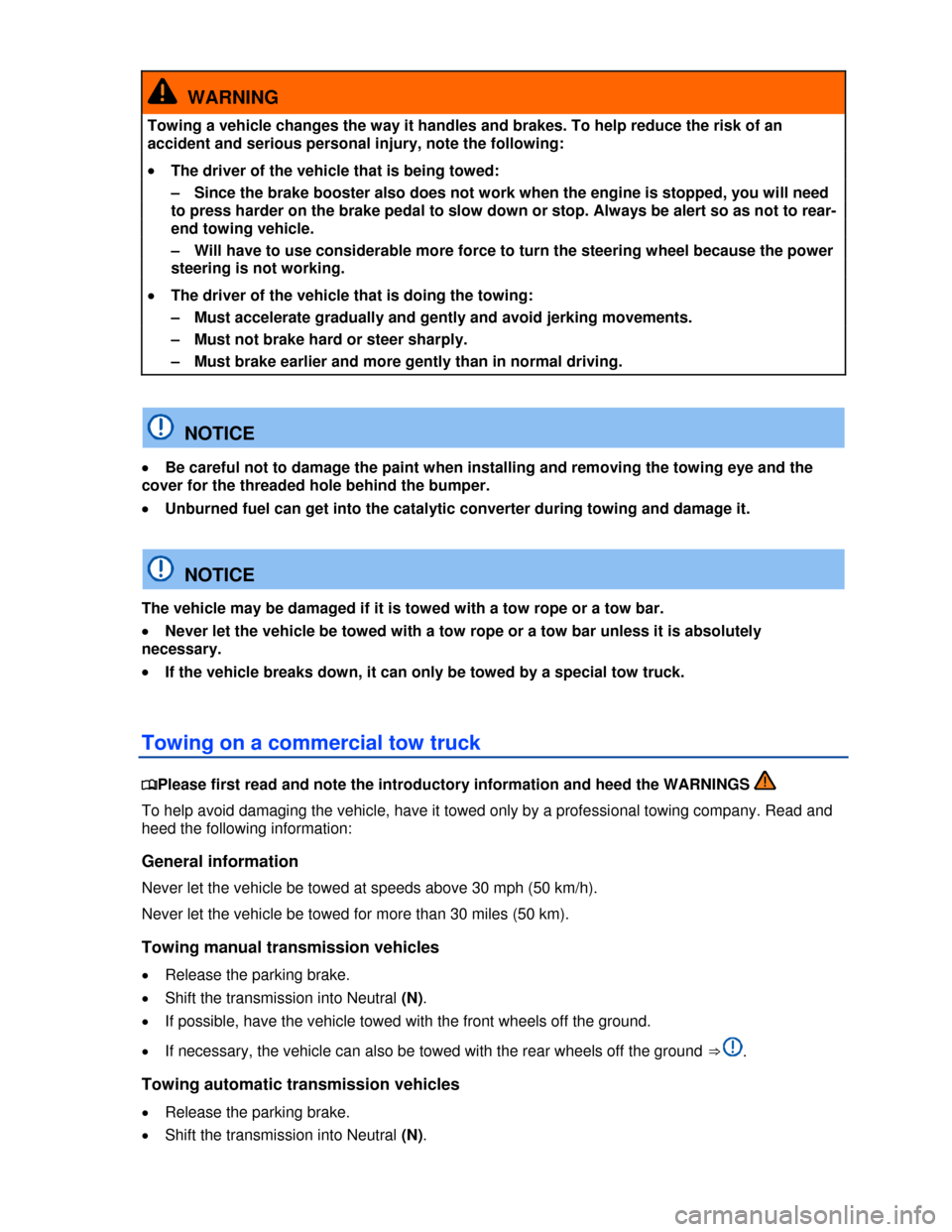Page 297 of 356

Stowing the replaced wheel
One of the vehicles normal wheels will not fit in the well for the compact spare wheel in the floor of the
luggage compartment. Therefore, in the event of a flat tire, the wheel which was changed must be
secured, for example, with suitable straps in the luggage compartment.
Open the rear hatch, raise the entire luggage compartment floor, press the retaining pin (1) to the right
and slowly lower the luggage compartment floor.
Put the wheel you took off the vehicle into the spare wheel well so that the center hole of the rim is
aligned with the threaded pin.
Turn the threaded retainer in the center of the compact spare wheel (2) clockwise until the wheel
replaced is securely in place.
If necessary, return the vehicle tool kit to its location in the luggage compartment.
Raise the floor covering and release the retaining pin, then fold the floor covering back down onto the
floor of the luggage compartment.
Close the rear hatch.
Differences between the road tires and the compact spare
The compact spare is different in design from the road tires and must be used only in the event of a
flat tire, only for a brief time, and only when driving with extra caution ⇒ .
Replace it with a tire matching the others on your vehicle as soon as possible.
Please heed the following:
�x Do not drive faster than 50 mph (80 km/h)!
�x Avoid full-throttle acceleration, hard braking and fast cornering!
�x Do not use snow chains on the compact spare wheel
�x After installing the compact spare tire, check the tire pressure as soon as possible
Check the tire inflation pressure of the compact spare whenever you check the tire pressure of the
road wheels, at least once a month. Inflate a compact spare tire to the cold tire pressure specified for
the compact spare on the tire pressure label or on a separate label for the compact spare, if there is
one.
Page 323 of 356
Description Possible causes among
others Possible remedy
Tire pressure too low. Adjust tire pressure
Driving in the mountains. No direct corrective action possible.
Towing a trailer or driving with
a roof rack.
– Check use.
– Remove if not in use.
Driving with heavy payload. No direct corrective action possible.
Driving at high engine speed. Select a higher gear.
Page 325 of 356

Checklist
For your own safety and that of your passengers, carry out the following steps in the order listed ⇒ :
1. Park the vehicle at safe distance from traffic and on a suitable surface ⇒ .
2. Switch on emergency flashers by pressing the �� switch ⇒ fig. .
3. Apply the electronic parking brake to help prevent the vehicle from moving
4. Shift the transmission into Park (P) (automatic) or Neutral (manual only)
5. Stop the engine and remove the key from the ignition switch
6. Have all passengers exit and go to a safe location away from moving traffic, such as behind a
guard rail.
7. Take all vehicle keys with you when leaving your vehicle.
8. Set up a warning triangle or other warning device in order to alert other motorists and cyclists.
9. Let the engine cool down and get expert assistance if necessary.
If the emergency flashers are on, use the turn signal lever to indicate a direction or lane change, for
example when the vehicle is being towed. This temporarily interrupts the emergency flashers.
Switch on the emergency flashers when:
�x Traffic suddenly slows down or stops in front of you to warn those approaching from behind.
�x In any emergency situation.
�x If the vehicle breaks down.
�x When being towed.
Always obey traffic laws that govern the use of emergency flashers where you are driving.
If the emergency flashers are not working, a different method – as permitted by law – must be used to
alert other motorists and cyclists to the breakdown.
WARNING
Disregarding the safety-related checklist may lead to accidents and serious personal injuries.
�x Always review and follow the checklist. Follow accepted safety practices and use common
sense.
WARNING
The vehicle exhaust system and the catalytic converter or diesel particulate filter get very hot.
They can cause fires and serious personal injury.
�x Never park where parts of the hot exhaust system or catalytic converter could ignite
flammable materials, such as dry grass, brush, leaves, spilled fuel, etc.
The vehicle battery will be drained if the emergency flashers are on for a long time – even if the
ignition is switched off.
Page 333 of 356
using this number. Record the code number of the wheel bolt lock and store it separate from
the vehicle.
(3) Screw-in towing eye.
(4) Hubcap puller clips for removing hubcaps, full wheel covers or wheel bolt caps.
(5) Jack. Before putting the jack back, be sure to completely crank the jack down to its original
position. Then the crank must be clamped against the side of the jack.
(6) Lug wrench.
(7) Folding chocks
Folding chocks
Fig. Unfolding the folding chock.
�
Page 352 of 356
Page 353 of 356

WARNING
Towing a vehicle changes the way it handles and brakes. To help reduce the risk of an
accident and serious personal injury, note the following:
�x The driver of the vehicle that is being towed:
– Since the brake booster also does not work when the engine is stopped, you will need
to press harder on the brake pedal to slow down or stop. Always be alert so as not to rear-
end towing vehicle.
– Will have to use considerable more force to turn the steering wheel because the power
steering is not working.
�x The driver of the vehicle that is doing the towing:
– Must accelerate gradually and gently and avoid jerking movements.
– Must not brake hard or steer sharply.
– Must brake earlier and more gently than in normal driving.
NOTICE
�x Be careful not to damage the paint when installing and removing the towing eye and the
cover for the threaded hole behind the bumper.
�x Unburned fuel can get into the catalytic converter during towing and damage it.
NOTICE
The vehicle may be damaged if it is towed with a tow rope or a tow bar.
�x Never let the vehicle be towed with a tow rope or a tow bar unless it is absolutely
necessary.
�x If the vehicle breaks down, it can only be towed by a special tow truck.
Towing on a commercial tow truck
�
Page 354 of 356

�x Tow the vehicle only with its front wheels off the ground ⇒ .
Special towing instructions for vehicles with all-wheel drive (4MOTION)
�x To help prevent unnecessary damage, vehicles with all-wheel drive (4MOTION) must be
transported on a flat-bed truck.
�x To load the vehicle on the flat bed, use the towing eye found in the vehicle tool kit and attach it to
the front anchorage
When not to tow your vehicle
If there is little or no oil in the transmission because of damage to your vehicle, it must be moved with
the drive wheels off the ground. The vehicle can only be towed if its ignition is switched on and its
electrical system is operating. In the following situations, the vehicle cannot be towed at all and must
be transported on a flatbed truck or trailer:
�x If the front and rear wheels cannot turn.
�x If the vehicle battery is dead (because the steering is locked and the electronic parking brake and
the electronic steering column lock cannot be released if engaged).
�x If you have to tow an automatic transmission vehicle more than 30 miles (50 km).
WARNING
It is not safe for children or other persons to ride in a vehicle that is being towed.
�x Never let children or anyone else remain in the vehicle while it is being towed.
NOTICE
The drive axle rotates while the vehicle is being towed with its rear wheels off the ground. This
can damage the automatic transmission.
�x Never tow automatic transmission vehicle with the rear wheels off the ground.
�x Tow manual transmission vehicles with the rear wheels off the ground only if it is certain
that no transmission fluid can leak out.
Tips on towing
�
Page 355 of 356

�x Shift the gearshift lever to Neutral
�x Do not tow faster than 30 mph (50 km/h).
�x Do not tow more than 30 miles (50 km).
Towing automatic transmission vehicles
Check whether your vehicle can be towed at all; see below When not to tow your vehicle.
If yes, note the following for the towed vehicle:
�x Put the transmission in Neutral (N).
�x Do not tow faster than 30 mph (50 km/h).
�x Do not tow more than 30 miles (50 km).
�x When a commercial tow truck is being used, the vehicle must only be towed with the front wheels
lifted off the ground.
�x Follow the special instructions for towing vehicles with all-wheel drive (4MOTION).
Towing vehicles with all-wheel drive (4MOTION)
Vehicles with all-wheel drive (4MOTION) should be towed with a tow bar or a tow rope. If the vehicle is
towed with the front or rear axles lifted off the ground, the engine must be switched off. Otherwise the
powertrain may be damaged.
When not to tow your vehicle
In the following situations, the vehicle cannot be towed and must be transported on a flatbed truck or
trailer:
�x If transmission fluid has leaked out of the transmission.
�x If there is little or no oil in the transmission because of damage to your vehicle, it must be moved
with the drive wheels off the ground.
�x If the front and rear wheels cannot turn.
�x When the vehicle battery is dead, since the steering may remain disabled, and it may not be
possible to release the electronic steering column lock and the electronic parking brake.
�x If you have to tow an automatic transmission vehicle more than 30 miles (50 km).
Towing other vehicles
�x Obey all legal requirements.
�x Read and heed all towing information in the owner’s manual for the other vehicle.
A vehicle can be towed only if the electronic parking brake and the electronic steering column
lock can be released. In case of a power loss or malfunctions of the electrical system, the engine may
have to be jump-started in order to release the electronic parking brake and the electronic steering
column lock.
Driving tips while towing
�